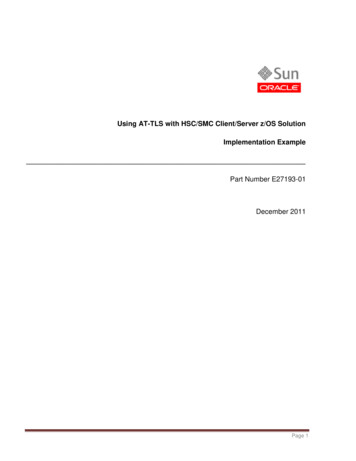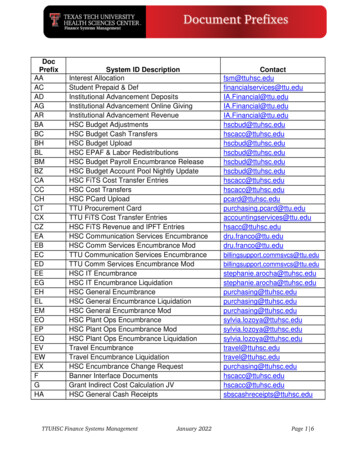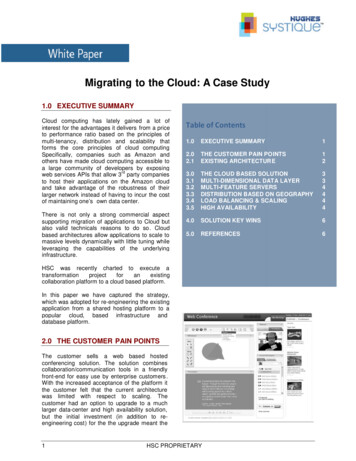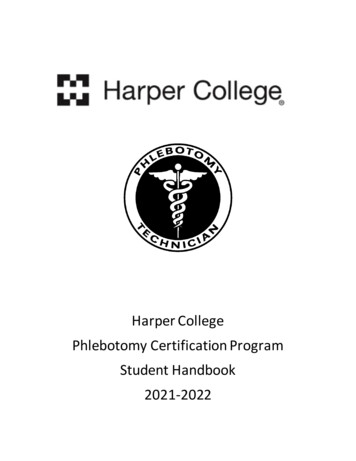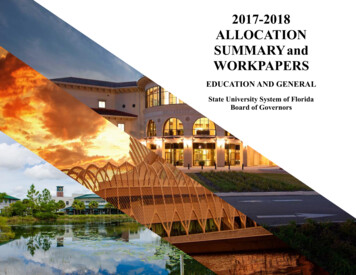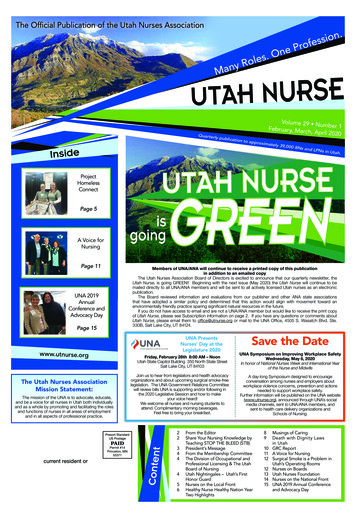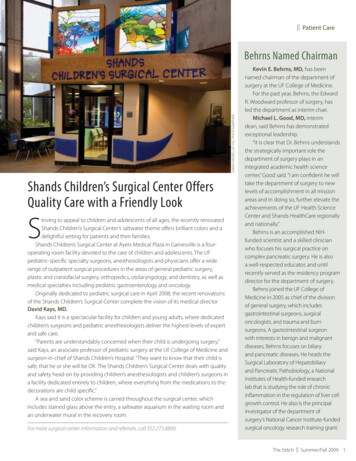
Transcription
Patient CareSarah Kiewel/UF HSC PhotographerBehrns Named ChairmanShands Children’s Surgical Center OffersQuality Care with a Friendly LookStriving to appeal to children and adolescents of all ages, the recently renovatedShands Children’s Surgical Center’s saltwater theme offers brilliant colors and adelightful setting for patients and their families.Shands Children’s Surgical Center at Ayers Medical Plaza in Gainesville is a fouroperating room facility devoted to the care of children and adolescents. The UFpediatric-specific specialty surgeons, anesthesiologists and physicians offer a widerange of outpatient surgical procedures in the areas of general pediatric surgery,plastic and craniofacial surgery, orthopedics, otolaryngology, and dentistry, as well asmedical specialties including pediatric gastroenterology and oncology.Originally dedicated to pediatric surgical care in April 2008, the recent renovationsof the Shands Children’s Surgical Center complete the vision of its medical directorDavid Kays, MD.Kays said it is a spectacular facility for children and young adults, where dedicatedchildren’s surgeons and pediatric anesthesiologists deliver the highest levels of expertand safe care.“Parents are understandably concerned when their child is undergoing surgery,”said Kays, an associate professor of pediatric surgery at the UF College of Medicine andsurgeon-in-chief of Shands Children’s Hospital. “They want to know that their child issafe, that he or she will be OK. The Shands Children’s Surgical Center deals with qualityand safety head-on by providing children’s anesthesiologists and children’s surgeons ina facility dedicated entirely to children, where everything from the medications to thedecorations are child specific.”A sea and sand color scheme is carried throughout the surgical center, whichincludes stained glass above the entry, a saltwater aquarium in the waiting room andan underwater mural in the recovery room.For more surgical center information and referrals, call 352.273.8800.Kevin E. Behrns, MD, has beennamed chairman of the department ofsurgery at the UF College of Medicine.For the past year, Behrns, the EdwardR. Woodward professor of surgery, hasled the department as interim chair.Michael L. Good, MD, interimdean, said Behrns has demonstratedexceptional leadership.“It is clear that Dr. Behrns understandsthe strategically important role thedepartment of surgery plays in anintegrated academic health sciencecenter,” Good said. “I am confident he willtake the department of surgery to newlevels of accomplishment in all missionareas and in doing so, further elevate theachievements of the UF Health ScienceCenter and Shands HealthCare regionallyand nationally.”Behrns is an accomplished NIHfunded scientist and a skilled clinicianwho focuses his surgical practice oncomplex pancreatic surgery. He is alsoa well-respected educator, and untilrecently served as the residency programdirector for the department of surgery.Behrns joined the UF College ofMedicine in 2005 as chief of the divisionof general surgery, which includesgastrointestinal surgeons, surgicaloncologists, and trauma and burnsurgeons. A gastrointestinal surgeonwith interests in benign and malignantdiseases, Behrns focuses on biliaryand pancreatic diseases. He heads theSurgical Laboratory of Hepatobiliaryand Pancreatic Pathobiology, a NationalInstitutes of Health-funded researchlab that is studying the role of chronicinflammation in the regulation of liver cellgrowth control. He also is the principalinvestigator of the department ofsurgery’s National Cancer Institute-fundedsurgical oncology research training grant.The Stitch Summer/Fall 2009 1
Dr. Brent Seagle (center), chief of plastic and reconstructive surgery, operateswith fellow Dr. Mark Clayman (left) as student Lee Ferguson watches.Beyond the FaçadeThe Good Works of Plastic SurgeryAny surgeon can repair a broken rib, but not everysurgeon can take that same rib and build you an ear.In today’s Hollywood-obsessed culture, it’s easy to forgetthe world of plastic surgery reaches far beyond nose jobs andfacelifts. Reconstructive plastic surgery can put a woman backinto a bikini after a battle with breast cancer or give a childwith a cleft lip the ability to smile.Of the 12.1 million plastic surgery procedures performedin 2008, 4.9 million were reconstructive surgeries, accordingto the American Society of Plastic Surgeons. Reconstructivesurgery is performed to improve or correct abnormalitiescaused by trauma, injury, infection, tumors or disease. This caninclude everything from creating skin grafts for burn victims toremoving cancerous tumors and reconstructing the area withflaps of tissue and blood vessels taken from other parts of thepatient’s body.“The biggest thrust of what we’re involved in is restoringform and function and trying to take that to the highest levelpossible,” said Matthew Steele, MD, an assistant professorof plastic and reconstructive surgery in the UF College ofMedicine.He said one of the reasons he was attracted to plasticsurgery was the chance to be innovative and find newsolutions to medical problems.“It’s not the same cookbook kind of surgeries,” he said.“There’s not necessarily a right answer all the time.”One of his cleft palate patients, a young girl, couldn’t smilebecause of her condition. Whenever she laughed or felt happy2The University of Florida Department of Surgeryshe couldn’t show that emotion on her face, Steele said. Herdoctors weren’t able to use the nerves they normally wouldfor a similar procedure, so they found a way to use the nervesassociated with chewing instead.The recovery was gradual, but she eventually learned to useher chewing muscles to smile and show emotion. Steele saidthe first time she passed a mirror in a store and realized she wassmiling she ran around laughing and yelling to her mother.“They came back and told everyone the story,” he said.“They were really happy.”M. Brent Seagle, MD, chief of reconstructive and plasticsurgery at UF, said helping children like this and helpingpeople get their lives back, in a sense, are the most rewardingaspects of reconstructive surgery.“It’s really rewarding when you get someone back to aplace of normal function when you get someone close towho they were before cancer or an accident,” he said.Seagle said the public still harbors some misconceptionsabout plastic surgeons and what they do.“There’s a good bit of misunderstanding,” Seagle said. “Thecosmetic side is sensationalized on TV, in newspapers, all overthe place.”He says another large part of the misunderstanding isthat people assume cosmetic surgery is always performed byplastic surgeons, and when they hear about botched surgeries,they don’t realize it wasn’t necessarily a plastic surgeon whoperformed the failed procedure.To achieve board certification, plastic surgeons are requiredto attend a U.S. accredited medical school and are subjectedto a rigorous examination process that assesses everythingfrom their surgical skills to their ethics and advertisingpractices, according to the American Board of Plastic Surgery.“Real plastic surgeons aren’t like ‘Dr. 90210,’” Steele said inreference to the popular reality show following an eccentriccosmetic surgeon in Beverly Hills.The field is constantly changing and innovating to findnew solutions and develop less-invasive procedures withshorter recovery times. In the future, Steele hopes to seemore developments in stem cell research and genetictissue engineering so plastic surgeons can use geneticallyengineered body parts rather than taking flaps from otherparts of the body or using donor transplants, which the bodycan reject.“When you get more experience you’re constantly makingchanges, and your work improves,” he said.UF Plastic Surgery recently moved into a new office, that offerseasy access and a comfortable setting. Learn more about thispractice at: www.floridaplasticsurgery.ufl.edu
Patient CareThe UF Department of Surgery is expanding its minimallyinvasive procedures with advanced laparoscopic liverresections at Shands. UF surgeon Robin Kim, MD, anassistant professor, is performing laparoscopic major liverresections – defined as removing more than three of theliver’s eight segments.“It’s not so much the amount of liver you take,” said Kim,“but a balance between too much and too little.” Kim addedthat what makes a laparoscopic liver resection advanceddepends not only on the magnitude of the resection butalso the surgeon’s ability to preserve liver tissue. Both requireproficiency in hepatobiliary and laparoscopic surgery.This is particularly relevant to a laparoscopic posteriorliver resection, which is rarely performed because it requiresaccess traditionally only achieved by open surgery.“It is very awkward to operate when the liver is hangingdown,” he said. “It is the most back part of the patient, so theaccess is difficult.”These liver resections can be performed on both benignand malignant tumors. The liver is the largest solid organin the body. In a normal liver, up to 70 percent of it can beremoved because it regenerates. However, some patientswith underlying disease can spare little.The advantage of laparoscopic liver resection overthe standard open surgery is patient recovery time. TheSarah Kiewel/UF HSC PhotographerAdvancedLaparoscopicLiver ResectionDr. Robin Kim performs a laparoscopicliver resection at Shands at UF.procedure cuts hospital stays by one to two days, but thesignificant difference is in the patients’ ability to return towork or their normal routine. Kim said generally for open liversurgeries patients can return to work in six to eight weeks, butrecovery time can drop to just four to six weeks for minimallyinvasive procedures.He said one pitfall of all laparoscopic surgery is that thesurgeon cannot rely on feel to detect small surface lesionsnot apparent on CT scans. In such cases, Kim performs ahybrid procedure in which a hand-sized incision, called ahand-port, is made allowing him to feel for such lesions. Theroutine use of laparoscopic ultrasound minimizes this need.“We’ve always been distinguished in our ability to performreally complex, big operations,” said Kim about the UFprogram. Laparoscopic liver surgery advances this ability andbrings more options to patients in Florida and beyond.Hospital’s New Tower Opens this NovemberThe Shands Cancer Hospital at the University of Florida and the Shands Critical Care Center is a 388 million,500,000-square-foot facility housing 192 private patient beds for a variety of inpatients, including those receivingoncology services, and a variety of outpatient and medical services, including emergency medicine andtrauma. UF surgeons will provide the latest in care for many patients in this new facility.Located within the new tower, the Shands Level 1 Trauma Centerfeatures four trauma rooms and two resuscitation rooms.Each trauma room has two bays, offering a radiologyand surgery area. The building adds an additional12 operating rooms, designed to evolve with anticipatedsurgical technology over the next 30 years.Learn more at shands.org.The Stitch Summer/Fall 2009 3
Chairman’s Message Best wishes,Kevin E. Behrns, MD, Chairman4The University of Florida Department of SurgeryA Legacy of HumanismSarah Kiewel/UF HSC photographerDear Friends:I am honored and humbled tobecome the fourth chairman of theUniversity of Florida department ofsurgery. All of us in the departmentowe much to those who created therich tradition of excellence in clinicalcare, research and education.With the beginning of a newera comes opportunity for assessment and strategicplanning for the department. Obviously, health care isbeing closely scrutinized nationally, and we must becognizant of potential changes so that our strategic visionincorporates upcoming changes in health-care deliveryand reimbursement systems. Importantly, many recentchanges in education and combination therapies forpatients mandate we deliver surgical care in the contextof a multidisciplinary team approach. This represents awonderful opportunity for our collegial, academichealth-care system at UF and Shands. Our department iseager to provide integrated care with colleagues withinthe department, College of Medicine and Shands. We havemultiple multidisciplinary examples, including our breastcancer program, gastrointestinal oncology program, andour burgeoning aortic treatment center which combinesthe talents of vascular and cardiovascular surgeons.Change will come not only in how we deliver surgicalcare, but also in where we deliver care, since our cancerhospital tower opens this November. This new facilitywill be an absolutely fantastic patient care venue, and amajor site for surgical care since it will house our traumaprogram and general surgery, including our oncology andgastrointestinal surgical programs. We will use this state-ofthe-art facility to offer high-quality surgical care and for thedevelopment of new, innovative care.Not only will we look forward to changes in clinicalcare, but we also anticipate growth in our basic scienceand clinical research programs. We are poised to translateour basic science findings into clinical care, and as westrategically evaluate our research programs we will seekevery opportunity to relate our findings to patient care.I look forward to working with our faculty, residents andstaff to build on our past successes so that we can create adepartment that provides high-quality, innovative surgicalcare via an integrated health-care team.(l to r) Darrell Hunt, MD, PhD, gathers with Curtis and Margaretta Walters,Hugh’s parents, Kevin E. Behrns, MD, and George Sarosi, MD, after the ceremony.Selected by his peers — in honor of a fellow surgicalresident adored by all — Darrell L. Hunt, MD, PhD,is the first recipient of the Hugh A. Walters, MD,Humanitarian Award.The award was created to honor the memory of Walters, asurgical resident who died unexpectedly in 2008. Presentedon June 10 at the conclusion of a special grand roundslecture on humanism, guest lecturer Robert T. Watson, MD,executive associate dean for administrative affairs at FloridaState University, who knew Walters throughout his medicaltraining, said “Hugh had wisdom, justice, courage andmoderation. He lived the values that reflect true humanism.He is the role model for all of us.”George A. Sarosi, MD, director of UF’s general surgeryresidency program, announced Hunt as the winner, sayingthe award is for excellence and dedication to patient care andteamwork, and for humility, and that he could not think ofanyone else who deserved it more.Upon accepting the award, Hunt said, “This is atremendous honor named after an extraordinary man —I hope my actions and work will live up to this honor.”Each year forward, through the Hugh A. Walters, MD,Humanitarian Fund, the UF department of surgery will hosta lecture and honor a current surgical resident with thehumanitarian award. The fund supports humanitarian effortsand awareness in surgical education.Regarding his interest in medicine, Hunt says he feels hispurpose is to help people maximize their potential and thatthis cannot be done in the setting of disease.“If you know you have cancer, it’s going to interfere withwhat you are able to do,” said Hunt, who plans to be a surgicaloncologist. “So for me, fighting against disease is my way ofhelping others maximize their human potential.”
Research & EducationCorporate Grant Enhances BurnEducation at UF College of MedicineUF Surgical Resident EarnsResearch Incentive AwardContinuing to help better preparestudents for their burn rotations,ConvaTec recently renewed a grant tothe UF department of surgery’s burneducation program.The 10,000 grant enables medicalstudents, surgical residents and fellowsto take the American Burn Association’sonline advanced burn life supporttraining during their first week on the burn service rotation.It also provides trainees with a pocket burn care manual forreference and a comprehensive book called Total Burn Care.David Mozingo, MD, a professor of surgery and directorof the Shands Burn Center at UF, said students coming ontothe rotation previously did not have the opportunity toreceive these types of educational resources.“By taking the advance burn life support course theycan get a good idea about how to manage a patient withinthe first 24 hours — something which they have very littlefamiliarity prior to the rotation,” said Mozingo.Medical student Sugong Chen, who completed theadvance burn life support course, offers an example of howthis training helps students.“A burn patient came in to the emergency room one nightwhile I was on trauma call, and I felt more than prepared tomanage that patient from the beginning to the end havingtaken this course,” said Chen.This is the second time ConvaTec has contributed tothe UF burn education program. The New Jersey-basedcompany’s mission is to create innovative health-caresolutions for better patient outcomes.Alex Cuenca, MD, a fourth-yearsurgical resident, recently received aResearch Incentive Award from theUF Medical Guild.Cuenca, who is taking threeyears out from his clinical trainingto earn a basic science researchdoctorate degree through UF’sInterdisciplinary Program inBiomedical Sciences, or IDP, is studying innate immunityand neonatal sepsis.He was one of 10 second-year IDP students to win theUF Medical Guild’s Research Incentive Award this past spring.Cuenca’s research project, “The role of interferon-gammainducible protein 10 in survival to neonatal sepsis,” wasselected as a winner by a student peer-review committee.Cuenca, who is planning to specialize in pediatricsurgery, said he hopes his research efforts will lead tothe discovery of a target for new or novel therapeuticsto prevent neonatal sepsis. He currently works in UF’sLaboratory of Inflammation Biology and Surgical Scienceunder the leadership of his faculty mentor, Lyle L.Moldawer, PhD, a professor and vice chairman of researchin the UF department of surgery.GUEST COLUMN UF College of Medicine Insider“Addressing the Need for More Surgeons”By: Kevin Behrns, MD, and Peter Nelson, MDLearn more about our department’s initiatives andgoals to address this need: www.surgery.ufl.eduSarah Kiewel/UF HSC photographerTraining for a Real-life Trauma CaseUF trauma medical director, Lawrence Lottenberg, MD,an associate professor of surgery, helps fourth-year medicalstudent Robert Weir find the correct location to insert achest tube on the department of surgery’s new simulator,TraumaMan. Designed by SimuLab Corp., the TraumaManSystem, which consists of synthetic human tissue, enablesstudents to practice a wide variety of advanced surgicalprocedures. TraumaMan was a gift from Larry and ChristineSmith. Lottenberg said thanks to the gift UF residents andmedical students now have the ability to practice critical lifesaving skills on the simulator any time of the day.The Stitch Summer/Fall 2009 5
Research & Discoveries Research BriefsStem Cell Marker Possible ‘Root’ of Colon CancerBreast MRI — Lymph Node Size not Signal of SpreadTo truly kill colon cancer and eliminate the risk of recurrence,it is important to kill the “root” of the disease, according to aUF College of Medicine surgeon.“It’s like a dandelion, if you don’t kill the root it just keepscoming back,” said Emina Huang, MD, a UF colorectal surgeon,who added that colon and rectal cancers have high recurrenceand spread rates, especially if the disease is not found early.Her findings, featured on the April 15 cover of CancerResearch, identify a biomarker for colon cancer stem cells thatshe believes will help researchers further evaluate the cancers’origins and progression. The discovery sheds light on the cancerstem cell theory, an idea that has arisen because cancer cellsand stem cells share many qualities, including the ability ofcancer stem cells to demonstrate self-renewal.The research determined a protein called aldehydedehydrogenase 1, or ALDH1, can be used to identify, isolate andtrack these ultra-resilient cells throughout the development ofmalignant colon or rectum disease. Previously used markerscannot as precisely track colon cancer stem cells.“Without a better handle on what cells might becontributing to cancer metastases and recurrence, we won’thave any targets to go after,” said Huang, an associate professorand a member of UF’s Program in Stem Cell Biology andRegenerative Medicine. “This gives us a potential target.”In addition to the potential advances in therapeuticstrategies, Huang said having a more direct target to explore willbenefit progress in the areas of diagnostics and prevention.In collaboration with Bruce Boman, MD, PhD, a professor ofmedical oncology at Thomas Jefferson University in Philadelphia,Huang chose to evaluate ALDH1 because of its knownassociation with breast, brain and other cancers. In additionto being a strong marker for malignant colon stem cells, theresearchers believe ALDH1 may be a marker for benign colonicstem cells. Whether these two types of colonic stem cells areone of a kind still needs to be determined.Researchers implanted human colon tissue cells into mice andanalyzed the resulting growth. Although normal cell tissue wasevaluated, it never replicated in the mice — only the tissue thatwas malignant grew. Comparing ALDH1 patterns with that of thepreviously used markers, the researchers found ALDH1’s presencewas much more targeted, suggesting a way to more definitivelyidentify colon cancer stem cells in the original tissues.Physicians treating breast cancer first look to lymph nodesin a patient’s armpit to see whether cancer is spreadingelsewhere in the body — but they may not be evaluatingthe nodes in the most effective way.Initial research suggested that enlargement andabnormalities of axillary sentinel lymph nodes — located in thearmpit area near the breast — were predictive of cancer. But aUF Shands Cancer Center researcher says it’s not the size of thenode or enhancement, but the loss of a key part of a normalnode’s structure called the fatty hilum that more accuratelysignals the spread of disease. The findings are available online inthe Journal of Magnetic Resonance Imaging.In addition to changing ideas about what doctors shouldlook for while evaluating lymph nodes, the finding reinforces thevalue of using MRI prior to surgery.“We found that the loss of fatty hilum in an axillary lymphnode on MRI correlated with finding the spread of breast cancerin axillary nodes at the time of surgery,” said Stephen Grobmyer,MD, an assistant professor of surgical oncology, who noted thatnot all nodes without fatty hilum necessarily had cancer.The UF study retrospectively examined 56 female patientsranging in age from 30 to 82. All women had a sentinel lymphnode biopsy. Fifteen women had cancer in the nodes thatrequired complete removal. Four of eight patients in whoma loss of fatty hilum was seen in an axillary node on MRI werefound to have cancerous lymph nodes at the time of their breastsurgery. By comparison, only 11 out of 48 patients, or 23 percent,with all fatty hilum in place had cancer.Grobmyer said these findings provide surgeons with anothertool to help personalize medicine and evaluate factors thatcould indicate whether cancer has spread prior to surgery.“I think this is another step to understanding how we can useMRI to improve care of breast cancer patients,” said Grobmyer,medical director of the UF Comprehensive Breast Center. “We arejust suggesting that there may be information that people havenot yet paid attention to that may impact our understandingof the staging of a patient’s disease. With this technology, ifyou look and see there is a node or several nodes with nofatty hilum, one would be very suspicious that there might bemetastatic disease present. Instead of doing an invasive sentinelnode biopsy, one could do a less invasive image-guided biopsyto obtain important staging information.”Visit www.surgery.ufl.edu/news.asp for the complete articles and more news about other research initiatives.6The University of Florida Department of Surgery
Faculty News & NotesPediatric Surgeon Honored withLifetime Achievement AwardSurgical Researcher Receives National HonorJames L. Talbert, MD, an emeritusprofessor in the division of pediatricsurgery, was awarded the UF College ofMedicine’s Lifetime Achievement Awardthis spring as part of the college’s 2009“Celebration of Research.”Talbert became UF’s first pediatricsurgeon when he joined the College of Medicine in 1967as founding chief of the division of pediatric surgery, aposition he held for more than 30 years. During his tenureat UF, Talbert developed innovative surgical techniquesfor the repair of congenital airway lesions and improvedsystems of care for injured children and pediatric cancerpatients.Although retired, Talbert continues to mentor andencourage faculty and students.Lyle L. Moldawer, PhD, a professorand vice chairman of research at theUF department of surgery, recentlywas honored with the Shock SocietyScientific Achievement Award.Bestowed during the society’sannual conference, held this June inSan Antonio, the award is presented to an outstandingscientist with lifetime contributions to the study of shock.Moldawer, who joined UF in 1993, established theLaboratory of Inflammation Biology and Surgical Science,which seeks to translate current developments inmolecular biology, gene therapy and functional genomicsinto the treatment of critically ill patients.This past spring he was awarded a UF ResearchFoundation Professorship, which is bestowed each year tojust 33 researchers campuswide.Cendan Named Assistant Dean forSimulation and Medical EducationVascular Surgeon Awarded InternationalVisiting ProfessorshipJuan Cendan, MD, was recentlyappointed assistant dean for simulationand medical education.Cendan has been a member of the UFCollege of Medicine since 2001 as anassociate professor in the departmentof surgery.He also serves as the clerkship director for thedepartment of surgery and the medical director forthe Harrell Professional Development and AssessmentCenter, a facility that offers patient simulation for medicalstudents to practice.In addition to his roles at UF, Cendan and twofaculty members in the department of computer andinformation science engineering have received twoNational Institutes of Health grants. One grant is fora surgical procedural simulation and the other is fordevelopment of virtual patients, which will give medicalstudents the opportunity to examine patients withconditions that human subjects can’t feign.This promotion will bring together his work as aneducator and his interest in simulation for medicallearning.Vascular surgeon Peter R. Nelson, MD,MS, spoke this spring in Australia asthe Association for Academic Surgery’sinternational visiting professor. Theprofessorship award is part of aleadership exchange program betweenthe AAS and the Younger FellowsCommittee of the Royal Australasian College of Surgeons.Nelson, an assistant professor, gave three talkswhile in Australia and moderated a research postercompetition. His talks focused on issues confronting thefield of surgery, research program development, and theimportant role of research in training future surgeons.Nelson’s clinical interests include endovascularabdominal aortic aneurysm repair, percutaneousperipheral intervention and minimally invasive treatmentfor venous disease. His research studying the relationshipof a procedure’s success or failure to a patient’s innateresponse to lower extremity revascularization is fundedby the National Institutes of Health.Nelson’s education interest is in understanding theissues surrounding medical students’ decision whetherto go into the field of surgery. He is creating a nationalvideo project to provide insight into the field and enhancerecruitment of future surgeons.The Stitch Summer/Fall 2009 7
TheStitchwww.surgery.ufl.eduEditorJennifer eduContributorsJessica Brandi, Karen Dooley, AlyssaLarenzie, Sarah Kiewel, Priscilla SantosDesignJS Design StudioUF Department of Surgery352.265.0646Kevin Behrns, MD, ChairmanGeneral Surgery352.265.0761Kevin Behrns, MD, Chief Acute Care SurgeryLarry Martin, MD, Director Gastrointestinal SurgeryKevin Behrns, MD, Director Surgical OncologySteven Hochwald, MD, DirectorPediatric Surgery352.273.8825David Kays, MD, ChiefPlastic andReconstructive Surgery352.273.8670M. Brent Seagle, MD, ChiefThoracic andCardiovascular Surgery352.273.5501Tomas Martin, MD, Interim ChiefTransplantation Surgery352.265.0606Richard Howard, MD, PhD, Interim ChiefVascular Surgery andEndovascular Therapy352.273.5484Thomas Huber, MD, PhD, Interim ChiefResearch Laboratories352.265.0494Lyle Moldawer, PhD, Vice ChairmanDepartment of SurgeryPO Box 100286Gainesville, FL 32610Children’s Surgical CenterLaparoscopic Liver ResectionReconstructive SurgeryResearch & DiscoveriesDepartment News & NotesInside this issue:The university of florida department of surgery Summer/Fall 2009TheStitchAdvancing theScience ofSurgical Care
The Shands Cancer Hospital at the University of Florida and the Shands Critical Care Center is a 388 million, 500,000-square-foot facility housing 192 private patient beds for a variety of inpatients, including those receiving oncology services, and a variety of outpatient and medical services, including emergency medicine and trauma.

